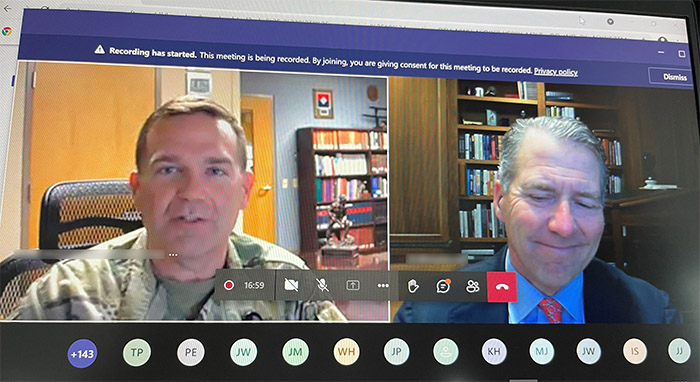USAISR Hosts a Medical Science, Technology Innovation Virtual Summit

The U.S. Army Institute of Surgical Research hosted a virtual Medical Science and Technology Innovation Summit on April 21 for the U.S. Army Futures Command, the U.S. Army Medical Research and Development Command and the University of Texas System. The intent of the meeting was to bring senior leaders and scientific experts from each organization together to foster interaction and explore future collaborations focused on solving problems for Warfighters on the battlefield, with an emphasis on turning the "Golden Hour" into the "Golden Day." The term Golden Hour refers to the first 60 minutes following a battlefield injury when proper medical treatment can be crucial to a Warfighter's survival.
During his opening remarks, Gen. John M. Murray, AFC commanding general, said talks for the summit had been proceeding until 14 months ago when the COVID-19 pandemic halted planning efforts. Murray also mentioned that he shared his vision of turning the Golden Hour to the Golden Day with Brig. Gen. Michael Talley, USAMRDC commanding general, when Talley took command of USAMRDC more than two years ago.
"I asked him to focus research on that because that is one of the tasks that Army Futures Command was stood up to do, and that's to begin to describe, not define, but describe what a future battlefield might look like," said Murray. "I don't have a definition for that, but if you don't understand what that could look like, then we're going to have a hard time defining our research priorities."
Murray envisions future battlefield unlike those from recent military conflicts where battlefield wounded casualties were receiving life-saving medical procedures within the first hour of the injury–the golden hour. The focus is now on providing prolonged medical care to service members deployed to remote and austere locations far from medical support where immediate evacuation from the point of injury is impractical.
"We're going to have to figure out how to sustain life at the point of injury a lot longer than we ever have in the past," said Murray. "So, I think there's all kinds of areas that we can collaborate in."
During his comments, UTS Chancellor James B. Milliken agreed with Murray that collaboration between UTS and AFC focusing on extending that crucial window of care is one of the most important things for American Service Members on the battlefield. Milliken, who leads one of the largest public university systems in the U.S., noted that UT universities in Dallas, Arlington, Austin and San Antonio have some of the nation's best bio engineering programs, automation of robotics research, advanced computing centers and centers for brain health.
"My colleagues and I are proud to be able to partner with Army Futures Command to work on such a critically important project to leverage expertise across multiple institutions and programs," said Milliken. "This is great for the Army, great for Texas, great for the universities and great for our Nation. I know that I speak for General Murray when I say that we're turning to you [summit attendees], the best minds in these fields to take us to the next level of innovation in trauma care."
Murray and Talley both mentioned the U.S. military's success in improving the survival rate of Service Members wounded in battle to more than 90 percent during the last 20 years of war in Iraq and Afghanistan. Talley credited the survival rate success to air superiority and air dominance in all theatres of operation.
"We don't expect that to continue," said Talley. "Getting evacuation conducted in a way that we don't conduct now using robotics and unmanned aerial systems, perhaps, that represents exactly what we're going to need in the future.
"And the fact that MRDC is under the Army Futures Command keeps us in line with where we're going as a military and it's important that we're able to amalgamate the best minds that America has to offer."
Col. (Dr.) Mark Stackle, USAISR commander, moderated the summit's briefs from each senior leader during the first part of the summit in the morning. The afternoon portion of the meeting featured six breakout sessions where each USAISR Combat Casualty Care Research Team presented their research focus to encourage discussions and future collaborations.
"I think we've put together a pretty tremendous program, alongside our UT Systems partners," said Stackle. "We really hope that this session will provide the spark for future collaboration opportunities between the Army Futures Command and the institutions within the University of Texas System."
The six USAISR CRTs focus on the following topics: Oxygen Delivery to Tissues and Shock Management; Hemorrhage and Vascular Dysfunction; Metabolic Failure and Organ Dysfunction; Wound Progression and Infection; Pain, Sensory Trauma and Mental Status and Engineering Solutions to Enable Combat Casualty Care.
USAISR is a direct reporting unit of USAMRDC and is the Army's premiere research organization focused exclusively on the combat wounded. USAISR is also the home of the only Burn Center in the U.S. Department of Defense.














